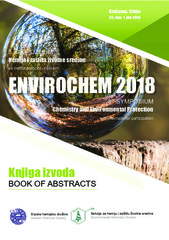| dc.description.abstract | Polycyclic aromatic hydrocarbons (PAHs) is a common name for a large group of organic compounds with two or more fused aromatic rings. PAHs are well known for their toxicity [1,2]. Because of that they keep attracting great interest on many environmental studies. PAHs can have natural or anthropogenic origin. In nature, PAHs are produced during fires and volcanic eruptions, during formation of petroleum and coal, as a result of diagenesis of organic matter and by biosynthesis. The main anthropogenic sources of PAHs are processing of coal and crude oil, combustion and vehicle traffic [3]. Urban street dust is the sink of PAHs from different sources [4,5]. There is a general agreement that the higher amounts of PAHs in street dusts, the higher human exposure risk to these pollutants via inhalation, ingestion, or dermal contact [6]. The aim of this study was a preliminary investigation of PAHs in street dust of the Pančevo city, Serbia.
A representative composite street dust sample was collected from different locations in the Pančevo city. Using a set of stainless steel sieves the particles were fractioned into three sizes with diameters of: < 63 μm, 63 – 250 μm, and 250 – 500 μm. The street dust particles were extracted and the extracts were cleaned up and fractionated using column chromatography. PAHs were analysed by gas chromatography – mass spectrometry (GC-MS) in a selected ion monitoring (SIM) mode. The ions monitored were: m/z = 128 (naphthalene), m/z = 152 (acenaphthylene), m/z = 154 (acenaphthene), m/z = 166 (fluorene), m/z = 178 (phenanthrene and anthracene), m/z = 202 (fluoranthene and pyrene), m/z = 228 (benzo[a]anthracene and chrysene), m/z = 252 (benzo[b]fluoranthene, benzo[k]fluoranthene, benzo[j]fluoranthene, benzo[e]pyrene and benzo[a]pyrene), m/z = 276 (indeno[1,2,3-c,d] pyrene and benzo[g,h,i]perylene), and m/z = 278 (dibenzo[a,h]anthracene). The results showed that all PAHs investigated were present in the analysed composite sample. Furthermore, a non-target screening of the extracts indicated presence of some other environmentally important aromatic hydrocarbons such as: acetophenone,
benzophenone, biphenyl and retene. The analysis of the distribution pattern of the PAHs different in size in different size fractions revealed a possible size fractionation of three- and tetracyclic PAHs. These results indicate that PAHs represent an important component in the street dust of the Pančevo city and point to the need for future investigation of the dust samples from this locality. | en |


